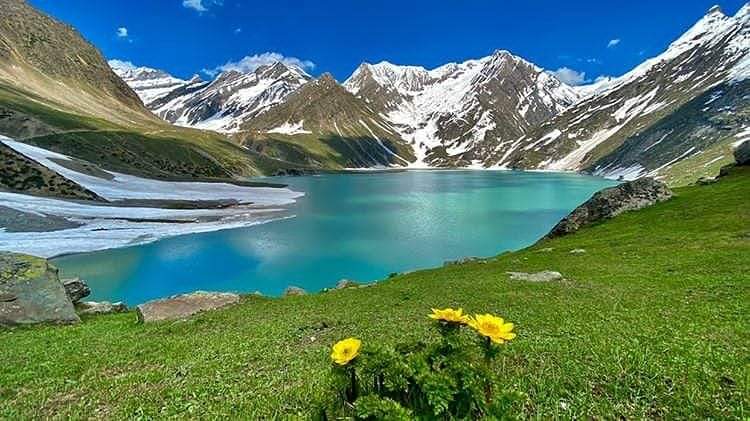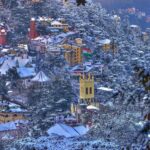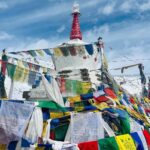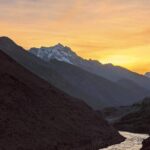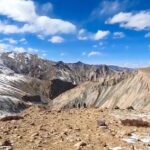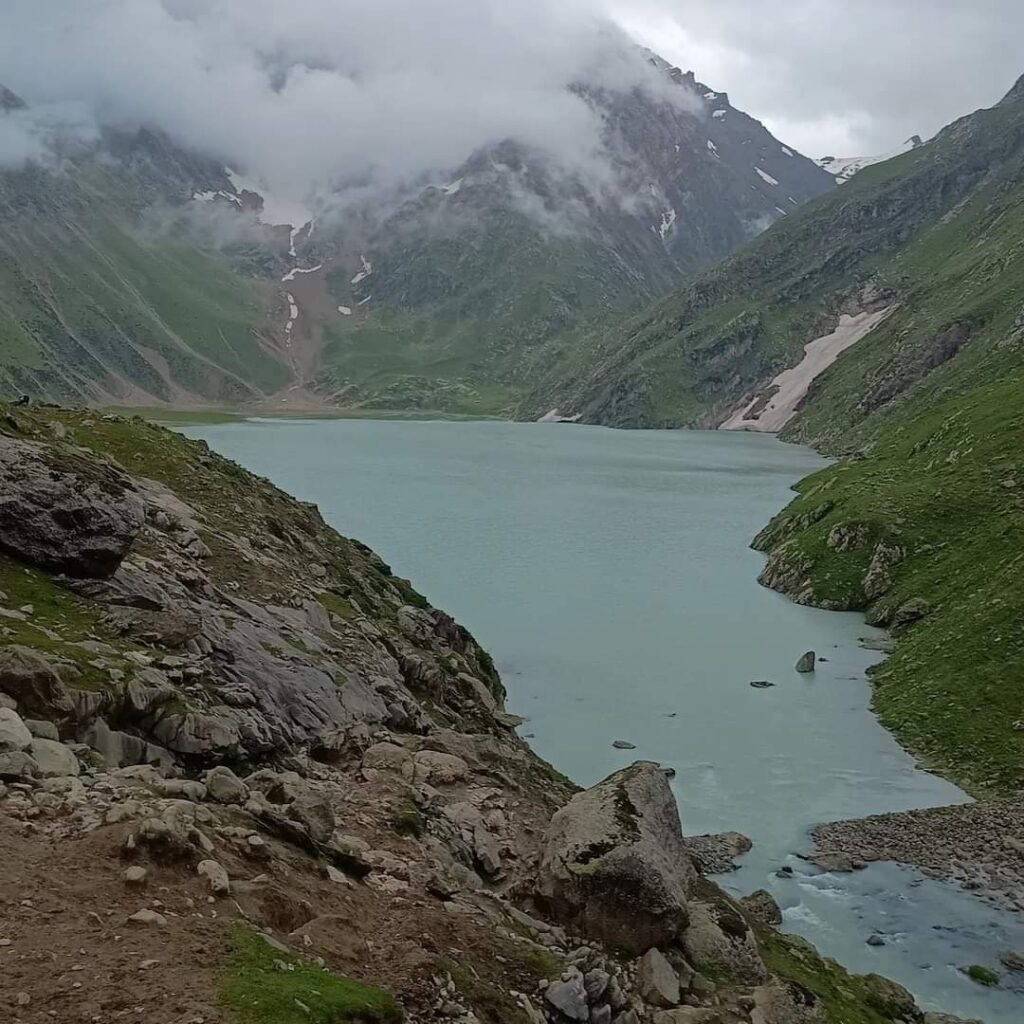
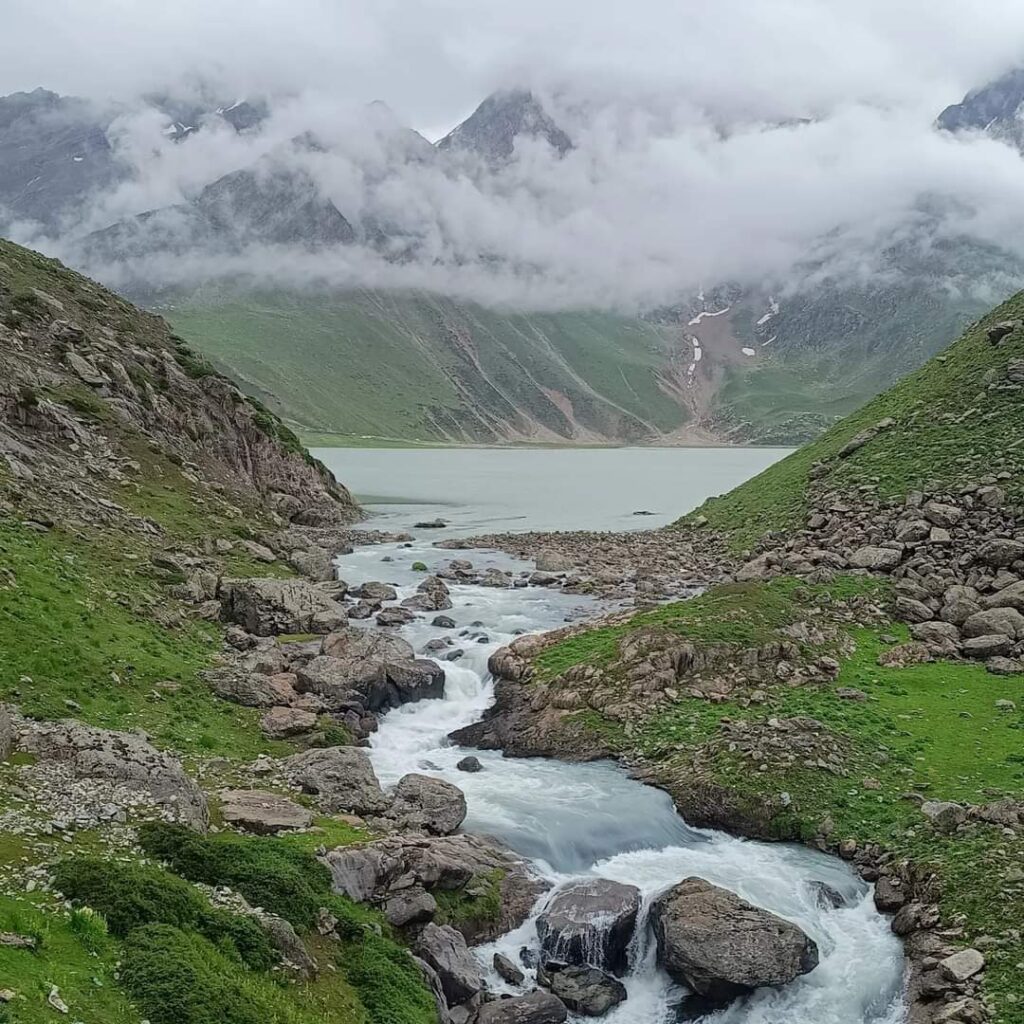
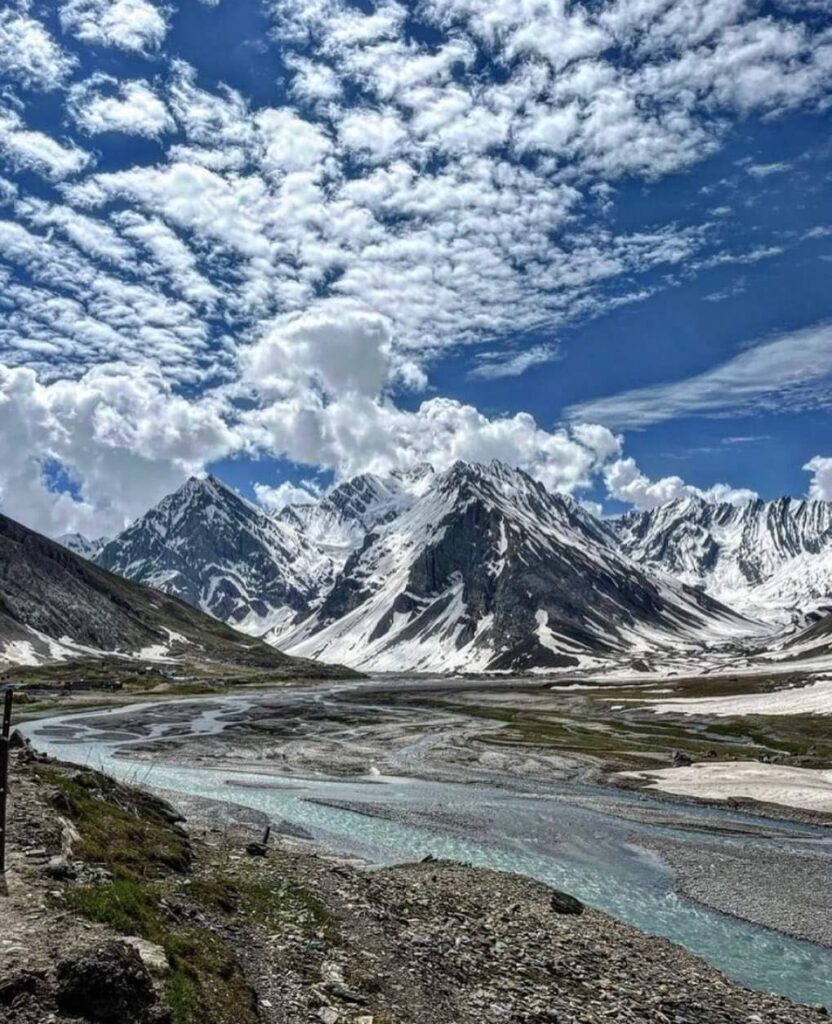
Sheshnag Lake
Sheshnag is a lake in Jammu and Kashmir, surrounded by tall mountains. It’s called Sheshnag Lake because it looks like a snake. You can get there by going on an exciting hike from Chandanwari. The hike takes you through beautiful places like forests and rocky areas.
During the hike, you’ll see amazing views of snowy mountains and waterfalls. Nature lovers and adventure seekers love it here. When you reach Sheshnag, you’ll be amazed by its calm and clear water. It’s surrounded by big mountains and green fields, making it peaceful and quiet.
The mountains and trees around the lake reflect on the water, making it look even more beautiful. Sheshnag is also a great place for birdwatching, with many different birds flying around. If you want more adventure, you can camp by the lake and sleep under the stars. The quiet sounds of nature will make it a special experience.
Sheshnag is also a sacred place for some people. They believe it’s where a special snake that belongs to Lord Shiva lives. Every year, many people go on a religious journey called the Amarnath Yatra and visit the lake.
Before you leave Sheshnag, take some time to enjoy the peace and beauty. Take photos and make memories. And remember to clean up after yourself and take your trash with you, so we can keep this beautiful place clean for the future.
Sheshnag is a place that will make you feel amazed by its beauty, calmness, and spiritual importance. It’s a must visit for anyone who loves nature.
Geography of Sheshnag Lake
Sheshnag Lake is a stunning high altitude glacial lake situated in the northern Indian region of Jammu and Kashmir. It is renowned for its remarkable geographic features, nestled within the towering Himalayan mountains. Here’s an overview of the geography of Sheshnag Lake:
Location
Sheshnag Lake is located in the Pahalgam region of Anantnag district in the Union Territory of Jammu and Kashmir. Specifically, it is part of the larger Lidder Valley, which is known for its breathtaking natural beauty.
Srinagar to Sheshnag: The distance from Srinagar to Sheshnag Lake is approximately 87 kilometers (54 miles) by road. The journey usually takes around 3 to 4 hours, depending on road conditions and traffic.
Pahalgam to Sheshnag: Pahalgam is the starting point for the trek to Sheshnag Lake. The trek from Pahalgam to Sheshnag is approximately 13 kilometers (8 miles) one way.
Betaab Valley to Sheshnag: Betaab Valley is located near Pahalgam. Since Sheshnag is reached via Pahalgam, the distance from Betaab Valley to Sheshnag would be the same as from Pahalgam, which is approximately 13 kilometers (8 miles) by trekking.
Aru Valley to Sheshnag: Aru Valley is also near Pahalgam, and the trekking distance from Aru Valley to Sheshnag would be similar to the distance from Pahalgam, which is around 13 kilometers (8 miles).
Altitude
The lake is situated at a significant altitude of approximately 3,574 meters (11,726 feet) above sea level. This high elevation contributes to the lake’s chilly and refreshing climate, making it a popular destination for trekkers and pilgrims.
Formation
Sheshnag Lake is a special kind of lake. It’s called a glacial lake because it was made by the ice from the big Himalayan mountains around it. When the ice melts because of the sun, it fills up the lake with very clean water. The name “Sheshnag” comes from Hindu stories, and it means there’s a snake god with many heads who’s thought to live deep in the lake.
Size and Shape
The lake looks special because it’s shaped a bit like a snake, which makes it even more interesting. It covers a space about the size of a big field, which is around 2.7 acres. The lake can change in size throughout the year. In the summer, when the ice in the mountains melts, it can get bigger. But in the colder months, it might become smaller.
Surroundings
Sheshnag Lake is surrounded by a stunning landscape. There are big, rough hills, rocky areas, and lots of tall trees. The huge, snowy mountains of the Himalayas make the lake look even more amazing. These mountains are covered in snow most of the time, which makes the lake even more beautiful.
Accessibility
To reach Sheshnag Lake, most people have to walk in the mountains, which is called trekking. The usual way to get there is by joining a big pilgrimage called the Amarnath Yatra. This journey is tough and takes you through different landscapes like thick forests and rocky trails, and you’ll see amazing views as you go.
History and Mythology of Sheshnag Lake
Sheshnag Lake is not only a beautiful place but also has a lot of stories from a long time ago. These stories are from Hindu religion, and they make this place very special. Let’s learn more about the history and mythology of Sheshnag Lake.
Mythological Significance:
The lake is called Sheshnag because of a story from Hindu religion. They say there’s a snake with many heads called Sheshnag, and it’s like a bed for Lord Vishnu, who is an important god in Hinduism. They say Lord Vishnu rests on this snake when everything in the world goes away and then comes back again.
- Amarnath Cave Connection: Sheshnag Lake is a special place on the Amarnath Yatra pilgrimage. People go on this pilgrimage to reach a sacred cave called the Amarnath Cave. Inside the cave, there’s a naturally formed ice statue of Lord Shiva called the Shiva Lingam, which people worship. It’s believed that Lord Shiva told Goddess Parvati important secrets about life and eternity in this cave.
- Lord Shiva and Sheshnag: In Hindu stories, they say that Lord Shiva and his wife, Goddess Parvati, used to come to Sheshnag Lake to take a bath in its clean water. People think the lake is special because of their presence there.
Historical Significance:
- Pilgrimage Destination: People have been visiting Sheshnag Lake for a very long time because it’s an important place for religious journeys. One of the biggest and most important religious journeys for Hindus is called the Amarnath Yatra. During this journey, people walk through difficult paths to reach a special cave called the Amarnath Cave. Sheshnag Lake is one of the important places people stop at during this journey.
- Cultural and Religious Heritage: The lake is important to the culture and religion of the area. Hindus really respect it, and when they go on a special journey to a place called the Amarnath Cave, they also visit Sheshnag Lake. This journey is a big part of their spiritual beliefs and what they do to show their faith.
Natural History:
- Glacial Origin: Sheshnag Lake’s creation is primarily due to the melting of glaciers from the surrounding Himalayan peaks. The crystal clear waters of the lake are replenished by the snow and ice that accumulate in the region.
- Flora and Fauna: The lake and its surroundings are home to a variety of flora and fauna, including alpine vegetation and diverse bird species. It is a haven for nature enthusiasts and wildlife lovers.
How to reach sheshnag lake
Reaching Sheshnag Lake requires some effort and planning, as it is a high altitude glacial lake located in the Himalayas.
Plan Your Trip:
- The best time is during the summer months, usually from June to September, when the weather is relatively mild and the lake is accessible.
- Obtain all necessary permits and permissions, especially if you plan to join the Amarnath Yatra pilgrimage, which includes a visit to Sheshnag Lake.
Reach Pahalgam:
- The starting point for the journey to Sheshnag Lake is usually Pahalgam, a popular hill station in Jammu and Kashmir.
- You can reach Pahalgam by road from Srinagar, the capital of Jammu and Kashmir, which has an airport.
- Alternatively, you can take a train to Jammu and then proceed to Pahalgam by road.
Trek to Sheshnag Lake:
- The most common way to reach Sheshnag Lake is by undertaking a trek as part of the Amarnath Yatra pilgrimage or as a standalone trekking expedition. The trek usually begins in Pahalgam.
Amarnath Yatra Route:
- If you are joining the Amarnath Yatra pilgrimage, you will follow a prescribed route that includes a stop at Sheshnag Lake.
- The Yatra is typically conducted during July and August each year. Pilgrims travel in organized groups with designated starting dates.
Standalone Trekking Route:
- If you are not part of the Amarnath Yatra and want to visit Sheshnag Lake independently, you can arrange for local guides and permits in Pahalgam.
- The trek usually covers approximately 13 kilometers (8 miles) from Pahalgam to Sheshnag Lake.
- The trail includes steep ascents and descents and passes through lush meadows, dense forests, and rocky terrain. You’ll need to be physically fit and prepared for the challenging terrain.
Accommodation:
- Accommodation options are limited along the trekking route. You may find basic guesthouses or tents in some areas.
- It’s essential to plan your accommodations in advance, especially during the Amarnath Yatra when thousands of pilgrims visit the region.
Safety and Health Precautions:
- Be prepared for high-altitude conditions, and acclimatize properly to prevent altitude sickness.
- Ensure you have appropriate trekking gear, including warm clothing, comfortable shoes, and essential supplies like water and food.
- Travel with a group or hire an experienced guide who knows the route well.
Environmental Responsibility:
- Practice responsible trekking by leaving no trace and respecting the natural environment.
Before embarking on your journey to Sheshnag Lake, it’s crucial to check the current travel advisories and conditions in the region, as the situation in Jammu and Kashmir can change. Ensure you are well-prepared and have the necessary permits and information for a safe and enjoyable trip to this beautiful Himalayan destination.
Top Things to do in Sheshnag
Sheshnag, known for its pristine glacial lake and stunning Himalayan surroundings, offers a range of activities and experiences for visitors. Here are some things you can do in Sheshnag:
Explore Sheshnag Lake: The primary attraction is Sheshnag Lake itself. Spend time by the serene waters, take in the breathtaking mountain views, and enjoy the peaceful atmosphere. If you’re visiting during the Amarnath Yatra pilgrimage, you’ll have the opportunity to take a holy dip in the lake.
Trekking: Sheshnag is a trekker’s paradise. There are several trekking routes in the region that offer varying levels of difficulty. You can trek from Pahalgam to Sheshnag Lake or explore nearby trails that take you through lush meadows, dense forests, and rocky terrain. Trekking in this pristine environment is a great way to experience the natural beauty of the Himalayas.
Wildlife Spotting: Keep an eye out for the diverse wildlife in the region. You may spot species like brown bears, leopards, musk deer, and various bird species. Birdwatchers will particularly enjoy observing the avian residents of the area.
Photography: Sheshnag’s stunning landscapes provide endless opportunities for photography. Capture the reflections in the lake, the snow-capped peaks, and the lush greenery. Sunrise and sunset are magical times for photography at sheshnag lake.
Camping: Camping near Sheshnag Lake can be an unforgettable experience. Set up camp and spend a night under the starry Himalayan sky.Be careful you follow Leave No Trace standards to safeguard the environment.
Spiritual Experience: If you’re part of the Amarnath Yatra, you’ll have a unique spiritual experience. Visit the holy Amarnath Cave and seek blessings from the naturally occurring ice Shiva Lingam. Pilgrims often perform rituals and prayers along the way.
Local Cuisine: Savor local Kashmiri cuisine in nearby villages or at base camps. Try dishes like Rogan Josh, Dum Aloo, and Kashmiri Pulao. Sip on traditional Kahwa tea and enjoy the flavors of the region.
Nature Walks: Take leisurely walks in the surrounding meadows and forests. These walks allow you to appreciate the natural beauty up close and spot local flora and fauna.
Stargazing: Sheshnag’s high-altitude location and minimal light pollution make it an excellent spot for stargazing. On clear nights, you can see a dazzling display of stars and constellations.
Interaction with Locals: Interact with the local Gujjar and Bakarwal communities, who have been living in these mountains for generations.
Mediation and Relaxation: The tranquility of the area makes it an ideal place for meditation and relaxation. Find a peaceful spot by the lake or on a mountain ridge to unwind and rejuvenate.
Adventure Sports: Depending on the season, you might find opportunities for adventure sports like snowboarding, skiing, and ice climbing in the nearby areas.
Remember to check local conditions and obtain any necessary permits or permissions before embarking on your activities in Sheshnag. Additionally, respect the local environment and wildlife to ensure this pristine area remains unspoiled for future generations to enjoy.
Tips for visiting Sheshnag
Visiting Sheshnag, especially if you plan to undertake the Amarnath Yatra pilgrimage or trek independently, requires careful planning and preparation due to its remote and high-altitude location. Here are some important tips to keep in mind for a successful and enjoyable visit to Sheshnag:
Check the Weather:
- Sheshnag is situated at a high altitude, and the weather can change rapidly. Even in the summer, be prepared for frigid weather. Check the weather forecast before you leave so you can dress accordingly.
Obtain Necessary Permits:
- If you’re joining the Amarnath Yatra pilgrimage, ensure you have all the required permits and registrations. The Yatra is subject to specific rules and regulations, and obtaining the necessary permits is essential.
Physical Fitness:
- Trekking to Sheshnag Lake can be physically demanding, so it’s important to be in good physical shape. Start a fitness regimen well in advance to prepare for the trek.
Acclimatization:
- Due to the high altitude, it’s crucial to acclimatize properly. Spend a day or two in Pahalgam or a lower-altitude location before starting the trek to Sheshnag to reduce the risk of altitude sickness.
Pack Appropriately:
- Pack warm clothing, including layers, as temperatures can drop significantly, especially at night. Waterproof clothing and sturdy hiking boots are essential for the trek. Don’t forget essentials like a good backpack, a first-aid kit, and a headlamp or flashlight.
Stay Hydrated:
-Altitude sickness might get worse from dehydration. To remain hydrated on the hike, drink lots of water. To ensure a clean water supply, it is advisable to travel with a water purifying device.
Local Guides and Porters:
- Consider hiring a local guide and porters, especially if you’re not experienced in high-altitude trekking. They can provide valuable guidance and assistance, carry heavy loads, and navigate the trails effectively.
Respect Local Culture:
- For Hindus, Sheshnag is a holy location. Observe local customs and culture with respect.. Be sure to adhere to the required rites and rules if you’re taking part in the Amarnath Yatra.
Leave No Trace:
- Follow the principles of Leave No Trace by disposing of waste properly and not disturbing the natural environment. Maintain the area’s cleanliness for future generations.
Safety Precautions:
– Be cautious while trekking, especially on steep and rocky terrain. Pay attention to your footing, and don’t take unnecessary risks.Always let someone know about your hiking intentions.
Emergency Contacts:
– Carry a list of emergency contacts, including local authorities and medical facilities, in case of any unexpected situations.
Photography Etiquette:
– If you’re taking photographs of local people, seek their permission first. Also, be mindful of sensitive areas and religious sites where photography may be restricted.
Travel Insurance:
– Consider purchasing travel insurance that covers high-altitude trekking and medical emergencies.
Plan for Accommodation:
– If you plan to stay overnight, book your accommodation in advance, especially during the Amarnath Yatra. In isolated locations, lodging choices may be scarce.
Local Cuisine:
– Try local Kashmiri cuisine, but ensure the food is prepared in hygienic conditions. Be mindful of food safety to avoid stomach issues during your trip.
By following these tips and being well prepared, you can have a safe and memorable visit to Sheshnag, enjoying its natural beauty and cultural significance while ensuring your well-being in this challenging but rewarding environment.
Photos and videos at Sheshnag lake
Photographing and capturing videos in Sheshnag can be a delightful experience due to its stunning natural beauty and serene surroundings. Here are some tips for capturing memorable photos and videos in Sheshnag:
Carry the Right Equipment:
- Bring a good-quality camera or smartphone with a reliable camera feature. If you’re a photography enthusiast, consider carrying a DSLR or mirrorless camera with a variety of lenses for different perspectives.
Research the Location:
- Before your trip, research Sheshnag’s geography, landmarks, and the best vantage points for photography and videography. Knowing the area in advance can help you plan your shots.
Golden Hours:
- Capture the lake and surrounding landscapes during the golden hours of sunrise and sunset. The soft, warm light during these times can add a magical touch to your photos and videos.
Reflections:
- Utilize the still waters of Sheshnag Lake to capture beautiful reflections of the surrounding mountains and sky. Calm mornings and evenings are ideal for mirror-like reflections.
Wide-angle and Telephoto Shots:
- Use wide-angle lenses for capturing the vast landscapes and telephoto lenses to zoom in on specific details, such as wildlife or distant peaks.
Rule of Thirds:
-To successfully arrange your photos, use the rule of thirds.. Divide the frame into thirds both horizontally and vertically, and place key elements along these lines or at their intersections.
Experiment with Angles:
-Don’t be afraid to try out different perspectives and viewpoints. Capture shots from low angles, high vantage points, or even from the lake’s shoreline to create diverse compositions.
Include Foreground Elements:
- Add depth and interest to your shots by incorporating foreground elements like rocks, flowers, or vegetation. This technique can make your photos more dynamic.
Portraits and Candid Shots:
- If you’re traveling with companions, capture portraits and candid moments to document the human element of your journey.
Time-lapse and Slow-motion:
– Experiment with time-lapse and slow-motion videos to showcase the changing light, movement of clouds, and the peaceful ambiance of Sheshnag.
Stabilization:
– Use a tripod or a stabilizer for steady shots, especially if you’re shooting in low light conditions or capturing videos.
Respect Local Customs:
– Be respectful when photographing local people or religious sites. Always ask for permission if necessary.
Capture the Journey:
– Don’t focus solely on the destination. Document your trek or pilgrimage experience, including the people you meet along the way and the challenges you overcome.
Backup Equipment:
– Bring extra batteries, memory cards, and chargers, as the availability of power sources may be limited.
Editing:
– After your trip, use photo and video editing software to enhance your shots, adjust colors, and add finishing touches. Avoid over-editing to maintain the authenticity of your captures.
Remember that while capturing beautiful photos and videos is important, it’s equally crucial to immerse yourself in the experience and appreciate the natural beauty and spiritual significance of Sheshnag. Strike a balance between capturing the moment and being present in the moment.
Best time to visit
The best time to visit Sheshnag Lake and enjoy nature largely depends on your preferences and the kind of experience you’re seeking.Every season has a special appeal and presents a variety of opportunities:
Spring (March to May):
- Spring is a wonderful time to visit if you enjoy mild weather and vibrant landscapes.
- During this season, the surrounding meadows come to life with colorful wildflowers, creating a picturesque backdrop.
- The temperatures are relatively pleasant during the day, but it can still be chilly at night, so bring warm clothing.
Summer (June to August):
- Summer is the most popular time to visit Sheshnag Lake, especially for trekkers and pilgrims.
- The weather is warmer during the day, making it easier for outdoor activities.
- The trails are mostly clear of snow, and the lake’s surroundings are lush and green.
- It’s an ideal time for birdwatching and camping by the lake.
Autumn (September to November):
- Autumn offers crisp and cool weather, making it a pleasant time for trekking and enjoying nature.
- The foliage begins to change, creating a beautiful mix of autumn colors in the forests and meadows.
- Fewer tourists visit during this season, providing a quieter and more peaceful experience.
Winter (December to February):
- Winter is a magical time to visit Sheshnag Lake if you’re prepared for very cold temperatures and snow.
- The lake and the surrounding mountains are covered in a thick blanket of snow, creating a serene and tranquil atmosphere.
- It’s an excellent time for snow enthusiasts who enjoy winter sports like skiing and snowboarding.
- Be sure to dress warmly, as temperatures can drop significantly below freezing.
Conclusion
Sheshnag is a remarkable destination that combines breathtaking natural beauty, rich mythology, and spiritual significance. Visiting this high-altitude glacial lake in the Himalayas can be an unforgettable experience, whether you’re part of the Amarnath Yatra pilgrimage or embarking on an independent trek.
From the pristine waters of Sheshnag Lake reflecting the surrounding snow-capped peaks to the challenging trekking routes that lead you through lush meadows and dense forests, Sheshnag offers a range of experiences for nature enthusiasts, trekkers, and pilgrims alike. It’s a place where history, mythology, and culture converge, creating a unique and captivating atmosphere.
As you plan your visit to Sheshnag, remember to prioritize safety, respect the local environment and customs, and immerse yourself fully in the natural and spiritual wonders that this Himalayan gem has to offer. Whether you’re capturing stunning photos and videos or simply savoring the moment, Sheshnag is sure to leave a lasting impression and a sense of wonder that will stay with you long after your journey.
Discover the Magic of Kashmir’s Natural Beauty in Our New Blog – An Adventure You Can’t Miss! Gulmarg , Dal Lake , Pahalgam , Tulip Garden , Doodhpathri Kashmir
